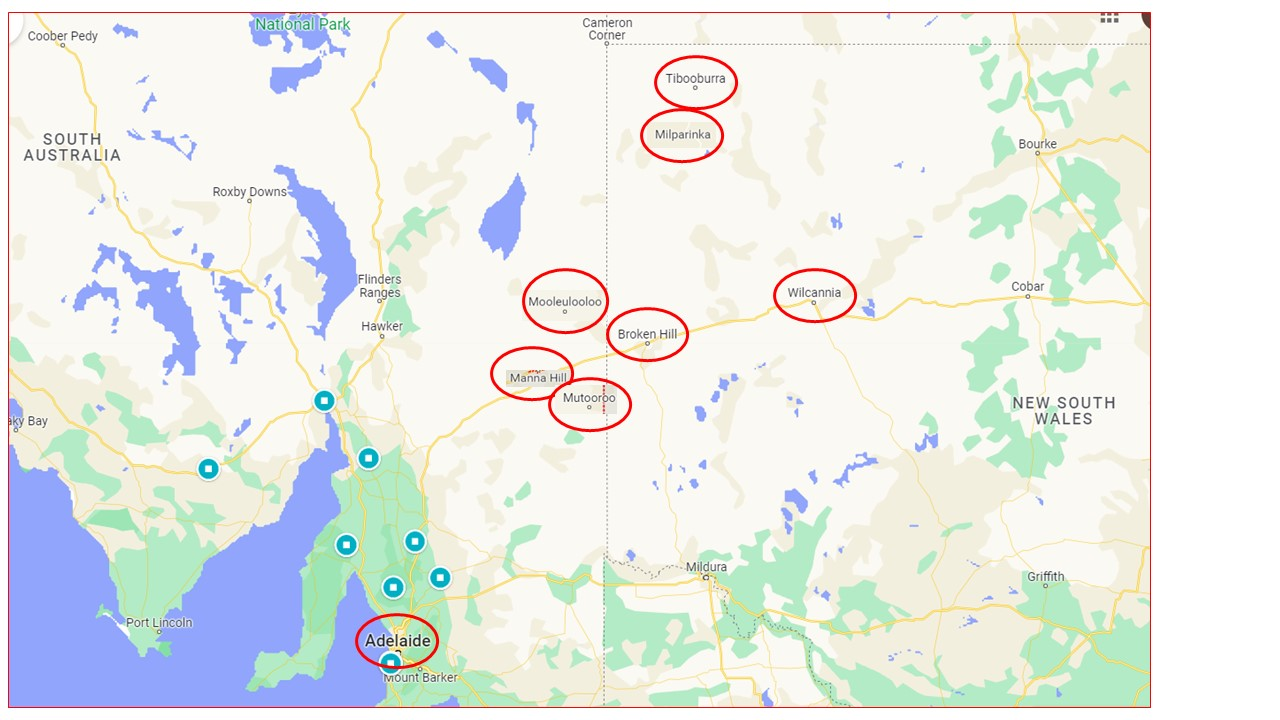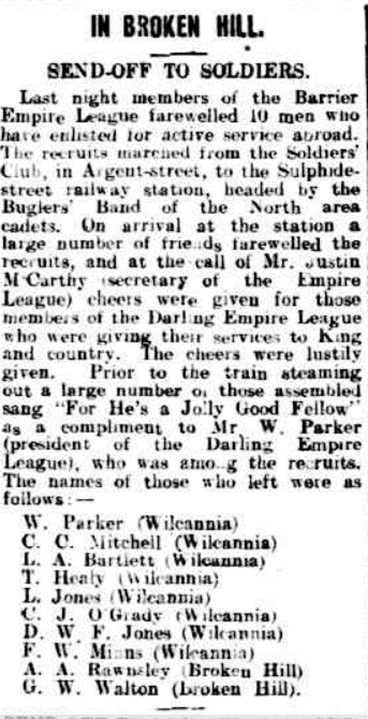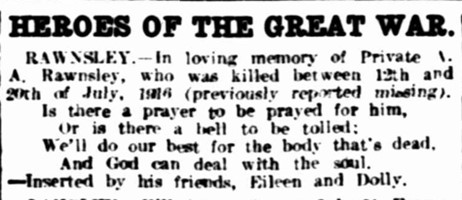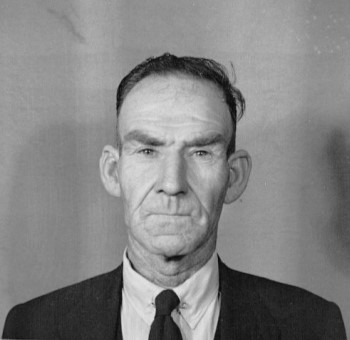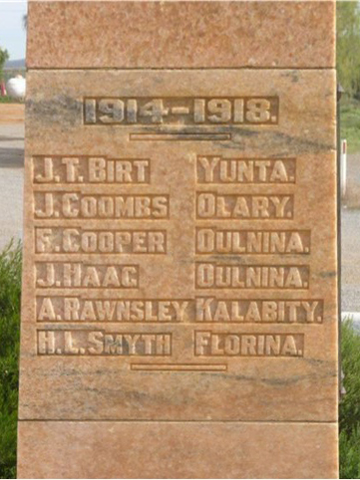
Albert Arthur RAWNSLEY
Eyes hazel, Hair light brown, Complexion fair
Albert Arthur Rawnsley - From the Outback to the Fields of France
Can you help us identify Arthur?
Albert Arthur Rawnsley was killed in Action at Fromelles. As part of the 30th Battalion he was positioned near where the Germans collected soldiers who were later buried at Pheasant Wood. There is a chance he might be identified, but we need help. We are still searching for suitable family DNA donors.
In 2008 a mass grave was found at Fromelles, a grave the Germans dug for 250 (Australian) bodies they recovered after the battle.
If you know anything of contacts here in Australia or England and Ireland, please contact the Fromelles Association.
See the DNA box at the end of the story for what we do know about his family.
The Rawnsley’s – A Family from Outback NSW/SA
Albert “Arthur” Rawnsley was the second youngest of nine children born between 1882 and 1897 to George Shaw Rawnsley and Annie Denny. Three of their children died in infancy, however. Arthur was born in 1894 in Broken Hill, New South Wales. His siblings were:
- Minnie (b 1882 Wilcannia)
- George (b 1884 Wilcannia )
- Percy (b 1889 Milparinka)
- Lilian (b 1891 Broken Hill)
- and Ruby (b 1897 Broken Hill).
George was from a Yorkshire family who had settled in Port Sorrell, Tasmania in about 1854. Annie’s family were from Dublin, Ireland who had settled in Balranald, New South Wales. They were married in Wilcannia Court House, NSW in 1881. What might have brought these two to Wilcannia in 1881? The river was the road. Wilcannia is located on the Darling River, the third largest inland port in the country during the river boat era. Cargo in and wool going out - a centre for the local pastoral industry.
Wilcannia was the location of a customs station on the Darling River. It was described as a "large and important centre of trade, where in 1881 £13,100 (£1.9M in 2023 value) was collected as Customs revenue". The river trade during the 1880’s was so extensive at Wilcannia that its Customs House was "probably the largest inland Customs Station in New South Wales".
Source Wikipedia.
By 1886, the Rawnsley family moved 300 km to Milparinka, a gold rush town from the 1870s that had Cobb and Co. coaches running to Wilcannia three times a week. At its height, Milparinka had a newspaper, a police office, a chemist shop, two butchers, a courthouse (1886), a school (1883), a hospital (1889) and four hotels.
Source: Wikipedia
They then moved to Broken Hill in about 1890. The Broken Hill School had opened in 1886, which all the children would have attended. George Rawnsley collected birds in the back country for various agencies and he also was a hawker. He would have relied on horses to take him out and was probably catching live birds with nets like the colourful dryland finches. His obituary in 1923 noted that he was “well known in Broken Hill”.
Source DEATH OF MR. G. RAWNSLEY (1923, December 20). Barrier Miner (Broken Hill, NSW : 1888 - 1954), p. 2. http://nla.gov.au/nla.news-article45630234.
However, it is likely that he never made enough money to properly support the family. Annie, with six young children, took out proceedings in 1898 on George on charges of wife desertion. George was ordered to pay 15s. a week towards his wife's support for 12 months.
Source 'POLICE COURT.', Barrier Miner (Broken Hill, NSW : 1888 - 1954), 24 May, p. 1. (FIRST EDITION), http://nla.gov.au/nla.news-article44212164.
But, he could not be traced, so the order was withdrawn. In 1898, young George was 14 and was likely already working to help keep the family together. Minnie, as the eldest female child, would have been expected to be helping her mother to bring up the younger children. By 1903, at 23, Minnie had married and was living in Adelaide. Arthur appears to have been of good build, 5’ 9 ½” and 151 pounds and with many opportunities in the mining industry, he may well have started working in the mines at a quite young age.
He states he was a miner on his enlistment papers. When the War started in mid-1914 thousands of Broken Hill miners lost their jobs due to the fact that much of the mining output had been exported to Germany and that suddenly ceased. By 1915, when Arthur enlisted, the allied war effort had seen the mines coming back to full production. Arthur is one of six soldiers inscribed on a War Memorial at Manna Hill, a railway town near towards the South Australia / New South Wales border. The memorial states he is from Kalabity, a pastoral station on the very dry salt bush scrub.
There was also a gold mine in the area, so he may have had connections to both. He listed his mother Annie’s address as nearby Wandaminga (Mooleulooloo), which means he must have been looking after her at the time, given her finances. George’s reenlistment papers in 1917 also show Annie’s address as Manna Hill, so she stayed in the area when Arthur was overseas.
Off to War
Percy was the first of the brothers to enlist, 21 December 1914 (2701). He was assigned to the 4th Light Horse Field Ambulance and became a driver. He was sent to Egypt in June, but returned to Australia in August due to illness. He did immediately ‘reenlist’ (4066), was assigned to the 12th Battalion and then headed back to Egypt at the end of November 1915. While in Egypt he had a number of illnesses, but he did head to France in August 1916. Percy continued to be plagued by illness during his service and there was also a note of a gunshot wound in his file.
He was eventually transferred to London January 1918 with trench feet and frostbite. He returned to Australia 12 April 1919. George (3697) tried to enlist, but was discharged shortly thereafter as medically unfit due to his poor eyesight. He tried again in July 1917, noting his eyesight issues, but was again discharged based on “special issues”. Arthur enlisted on 3 November 1915, in Adelaide. He was assigned to the 32nd Battalion, 4th reinforcements. The community in Broken Hill was proud of it’s soldiers and gave them a send off as they headed for training in Melbourne.
The first of the soldiers from the 32nd had headed off to Egypt on 18 November. Arthur’s reinforcements left Australia on 9 March 1916, arrived in Suez on 3 April and joined with the rest of the Battalion on 22 April at Ferry Post, by the Suez Canal.
With all the new recruits still coming in, reorganizations were ongoing and on 13 May Arthur was reassigned to the 30th Battalion. The 30th left Egypt for the Western Front on 16 June 1916 on HMAT Hororata, arriving in Marseilles on 23 June. After landing, there was a 60+ hour train ride to Hazebrouck, 30 km from Fleurbaix. They arrived on 29th June and were encamped in Morbecque.
Private F.R. Sharp (2134) wrote home:
“From the time we left Marseilles until we reached our destination was nothing but one long stretch of farms and the scenery was magnificent.” “France is a country worth fighting for.”
Training now included the use of gas masks and they also would have heard the heavy artillery from the front lines.
The Battle of Fromelles
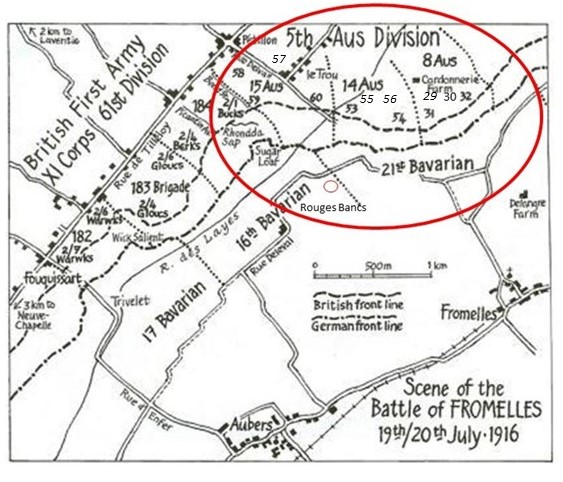
On 8 July they were headed to the front lines, first to Estaires, 20 km and the next day 11 km to Erquinghem, where they were billeted at Jesus Farm. They got their first ‘taste’ of being in the front lines at 9.00 PM on 10th July. A week later, they got orders for an attack, but it was postponed due to the weather. Then, on 19 July, the 29 officers and 927 other ranks of the 30th Battalion were into battle. The 30th Battalion’s role in the battle was to provide support for the attacking 31st and 32nd Battalions by digging trenches and providing carrying parties for supplies and ammunition. They would be called in as reserves, if needed, for the fighting.
The 32nd’s charge over the parapet began at 5.53 PM and the 31st’s at 5.58 PM. There were machine guns emplacements to their left and directly ahead at Delrangre Farm and there was heavy artillery fire in No-Man’s-Land. The initial assaults were successful and by 6.30 PM the Aussies were in control of the German’s 1st line system (Trench B in the diagram below), which was described as “practically a ditch with from 1 to 2 feet of mud and slush at the bottom”.
Source AWM4 23/49/12, 32nd Battalion War Diaries, July 1916, page 11
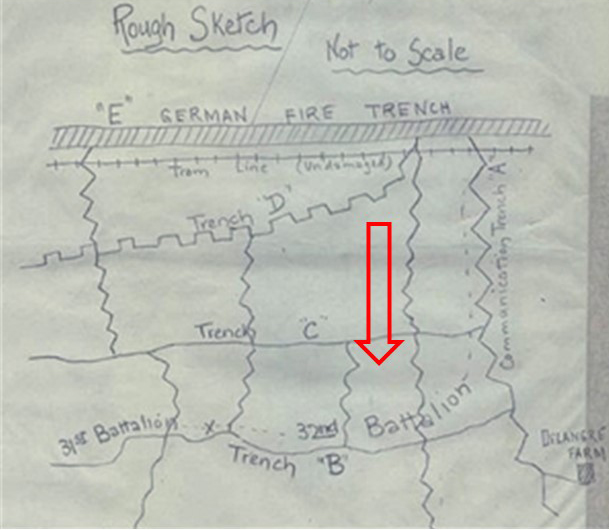
While their role was to be in support, commanders on scene made the decision to use the 30th as much-needed reinforcements. A necessary act, but it had consequences as it interfered with the planned flow of supplies.
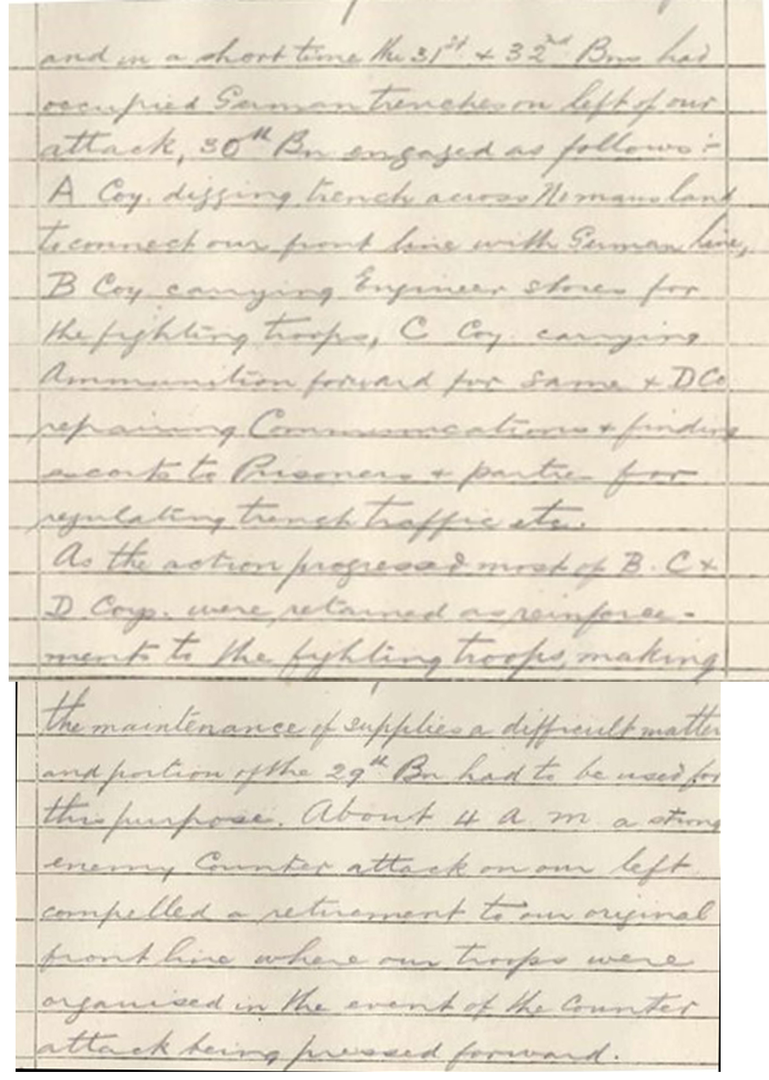
By 8.30 PM the Australians’ left flank had come under heavy bombardment with high explosives and shrapnel. Return bombardment support was provided and the 32nd Battalion was told that “the trenches were to be held at all costs”.
Source AWM4 23/49/12, 32nd Battalion War Diaries, July 1916, page 12.
When the 30th was formally called to provide fighting support at 10.10 pm. Lieutenant-Colonel Clark of the 30th reported:
“All my men who have gone forward with ammunition have not returned. I have not even one section left.”
Fighting continued through the night. The Australians made a further charge at the main German line beyond Trench B, but they were low on grenades, there was machine gun fire from behind from the emplacement at Delangre Farm and they were so far advanced that they were getting shelled by both sides. At 4.00 AM the Germans began an attack from the Australian’s left flank, bombing and advancing into Trench A (map).
Given the Australian advances that had been made earlier, portions of the rear Trench E had been left almost empty, which then enabled the Germans to be in a position to surround the soldiers. At 5.30 AM the Germans attacked from both flanks in force. Having only a few grenades left, the only resistance that could be offered was with rifles:
“The enemy swarmed in and the retirement across No Mans’ Land resembled shambles, the enemy artillery and machine guns doing deadly damage.”
By 10.00 AM on the 20th, the Germans had repelled the Australian attack and the 30th Battalion were pulled out of the trenches. Initial figures of the impact of the battle on the 30th were 54 killed, 230 wounded and 68 missing. To get some perspective of the battle, when Charles Bean, Australia’s official war historian, attended the battlefield two and half years later, he observed a large amount of bones, torn uniforms and Australian kit still on the battlefield.
The ultimate total was that 122 soldiers of the 30th Battalion were either killed or died from wounds and of this total 80 were missing/unidentified. To date (2024), 26 of those missing have been later identified and are buried in the Pheasant Wood Cemetery.
Arthur’s Fate
There are no records of what happened to Arthur during the battle, but he was among those missing in action. By the end of August there was news in the local papers about him being missing in action. Arthur’s ID tag was collected and returned by the Germans in early 1917, so he would have been well advanced in the battlefield for his tag to have been recovered. He was formally declared as having been killed in action in March 1917. While living in a sparsely populated area, two of his friends posted a memorial in several of the papers.
Arthur was awarded the Victory and British War medals and a Memorial Scroll and a Memorial Plaque. He is commemorated as one of six World War 1 soldiers inscribed on the War Memorial at Manna Hill, a railway town near towards the South Australia / New South Wales border. Unusually, their working or homeplace is individually recorded on the memorial, the great pastoral cattle stations in the remote northeast of South Australia. The Memorial is more than a hundred kms to the south of Kalabity. Only one of these six soldiers returned from the War. Arthur is also commemorated on Panel 2 at VC Corner, Australian Cemetery Memorial, Fromelles, France.
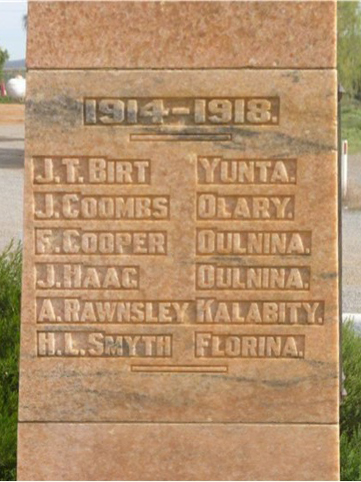
“MANNAHILL HONORS FALLEN SOLDIERS
War Memorial Unveiled
Little Mannahill, on the Broken Hill line, does not boast more than 100 citizens, but when it comes to community work the people can be as enthusiastic as those of the largest city.
Recently, according to Mr. W. S. Dyer a former Piriean, the townsfolk unveiled
a war memorial to the fallen of two conflicts with the aid of Brig. M. J. Moten, C.B.E., D.S.O. Sixty-eight former servicemen marched in procession, including a veteran of the Boer War, and there were about 400 present, some having come long distances. …
The new memorial is of imposing design in the form of an illuminated monument. After
the sounding of "Last Post" and "Reveille" was followed by the laying of many beautiful wreaths at the foot of the memorial. The dedicatory address was delivered by Padre Simpson, of Broken Hill. The main street, as well as the memorial, was profusely decorated with flags and bunting. The memorial is an 8-ft. tapered column of pink Angaston marble, sur-mounted by an illuminated dome and surrounded by a dwarf wall.”
After the War, Arthur’s brother Percy married Charlotte Hennessy and they had one child, Alfred, who died in infancy. Percy also enlisted for World War 2. In the 1960’s Percy was living in a War Veterans Home in Broken Hill. He died in 1970.
Could Arthur Still be Found?
The Commonwealth War Graves Commission carried out extensive searches after the War to find missing soldiers, but these efforts did not locate Arthur. As the Germans recovered his ID tag, they may have also recovered his body and he might be among the 70 remaining unidentified soldiers (2024) from a German burial pit from the battle that was found in 2008.
As of 2024, 26 of the 80 missing soldiers from the 30th have been identified from the 250 soldiers in the German mass grave at Pheasant Wood that was found in 2008. Family DNA donors are needed. If you know anything of their family in Australia or the UK, we would like to hear from you in hopes of being able to identify Arthur. See the DNA box below for what we do know about the family.
DNA samples are being sought for family connections to
| Soldier | Albert Arthur Rawnsley (1894-1916) |
| Parents | George Shaw Rawnsley (1857-1923) b Sorrell, Tasmania d Broken Hill NSW and Annie Denny (1860-1934) b Balranald, NSW |
| Siblings | Minnie May (1882-1972) b Wilcannia, married Brew | ||
| George (1884-1948 ) b Wilcannia | |||
| Percival (1889-1970 ) b Milparinka d Broken Hill, married – Charolette Hennessy | |||
| Lillian (1891-1985) b Broken Hill, d Adelaide, married Eglinton | |||
| Ruby Gladys (1897-1932 ) b Broken Hill d Adelaide |
| Grandparents | |||
| Paternal | James Rawnsley (1827-1884) d Hay NSW and Mary Shaw (1827-1881) | ||
| Maternal | Phillip Denny and Catherine Easton b Ireland d Ireland |
The Fromelles Association would love to hear from you

Contacts
(Contact: carla@fromelles.info or geoffrey@fromelles.info).
(Contact: army.uwc@defence.gov.au or phone 1800 019 090).
Donations
If you are able, please contribute to the upkeep of this resource.
(Contact: bill@fromelles.info ).
